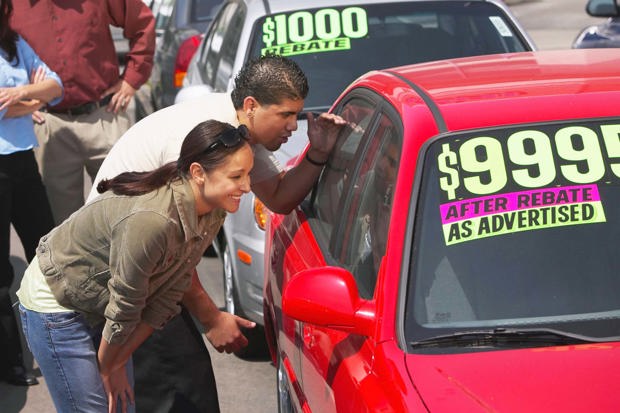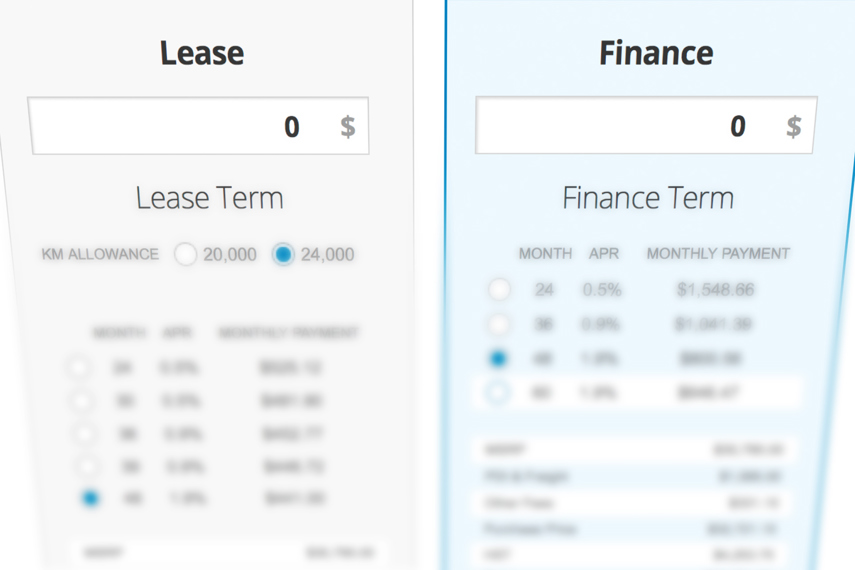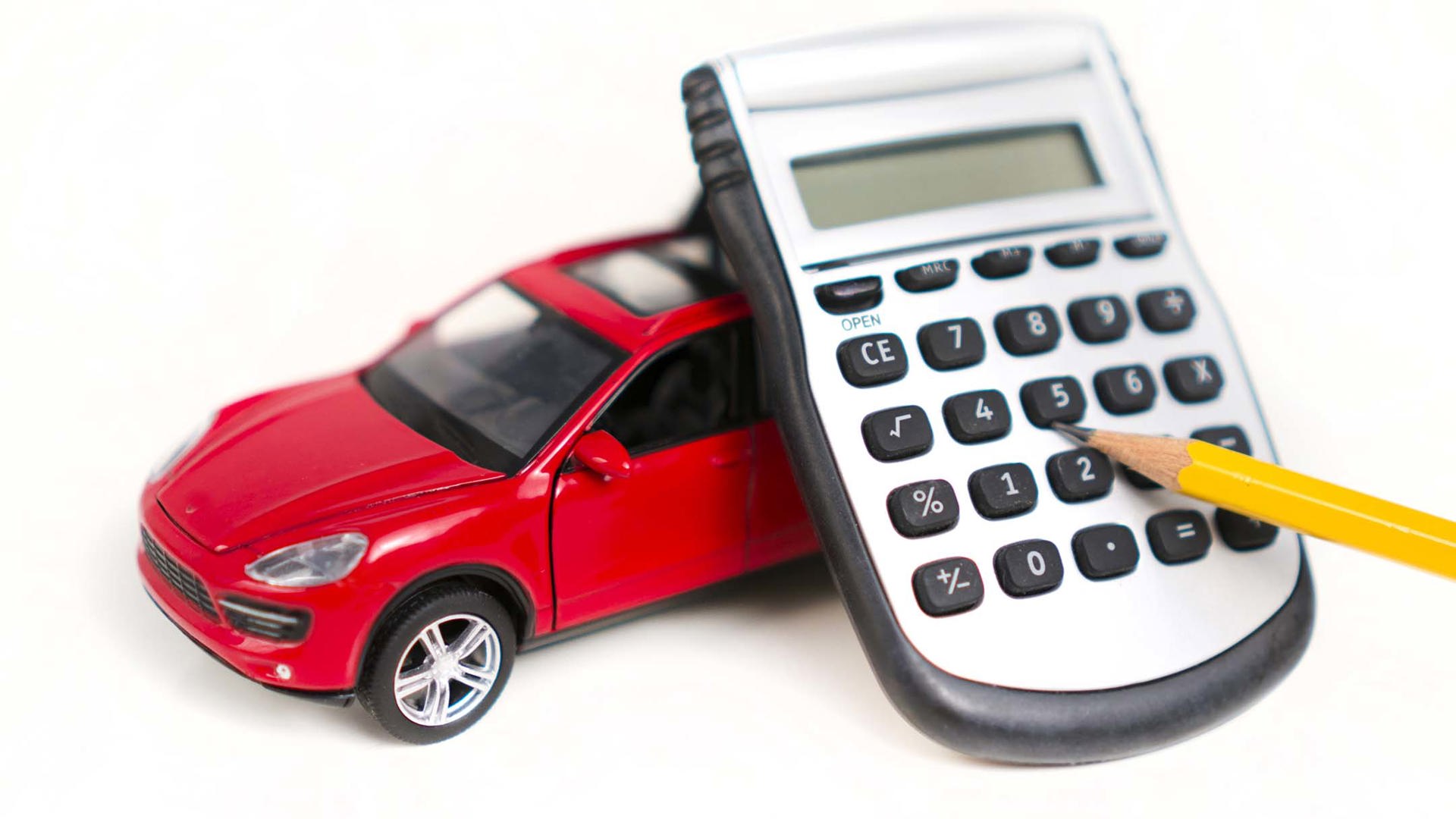For most people, buying a new car is the second-biggest expense they’ll make in their lives. And note that I said expense, not investment. Cars are rarely investments and for that reason alone, buyers should try to make a rational purchase based on needs and budget.
But let’s face it: if you’ve got a serious itch to buy a new car, that’s exactly when you get pumped – impulsive, even – rather than prudent with your finances. You’re keen; you’re ready to go. Maybe there’s a deal that can make it happen! You can bet there is.
Check out the huge sign that just went up at a local dealership. Lights are flashing, arrows are pointing, a giant inflated robot dances spasmodically out front.
“Zero down, zero percent financing,” is the message. “Come on in!”
And maybe on that day, at that time, that’s all it takes. Your old car seems to turn onto the lot by itself, and there you are in the showroom, inhaling the new-car smells, basking in the seductive gloss and shine. You can’t get a better deal than this, you’re thinking. Zero percent!
Let’s say you choose a car, settle on a price and sign a sales agreement. Your payments? Depends on the financing plan, and fortunately, they have someone right there who’ll handle the paperwork.
So what’s not to like?

Well, maybe that financing plan, because after choosing the vehicle, and working out the price, chances are, the paperwork indicates you’ll need a longer-term deal, which it likely turns out will not be a problem. On the contrary, seven years is not uncommon in Canada, up from the standard three- to five-year loans of a decade ago.
There’s even the possibility for car buyers to go for a 96-month loan, enabling them to buy a yet more expensive vehicle than they could with a 36- or 48-month loan. Hey, you can get that cool car you always wanted, and you don’t have to wait!
But imagine being stuck in a loan for nearly a decade paying off a vehicle that for most of the time is worth less than you owe. And when you finally do own it, you probably won’t want it. As time passes, it’s getting older and older, with repair bills likely mounting. Eventually, you just want out.
Again, no problem. Many dealers will take your aging car that you haven’t yet paid off in trade, bundle the outstanding balance into a new new-car loan and there you go! Except now you’re paying for two cars, one of which is no longer in your possession.
Sound good? No, not good at all. You’re carrying huge debt and you are monumentally “upside-down”, as they say in the trade (you have negative equity in bank-speak). You owe far more than the car you own will ever be worth, and in this situation you are unlikely to ever turn things around.
From the sublime to the ridiculous, as the saying goes.
Debt levels increasing across Canada

Turns out, we Canadians owe over $70 billion on car loans, and that’s just from the banks. At an average new car price of $38,000 (according to CBC’s Marketplace), it’s not surprising that long-term loans are required. And although car manufacturers do offer their own financing programs, dealer financing and bank financing are now not as separate as they used to be.
Sure, the manufacturer may have a zero- or very-low-percent interest offer that applies to some vehicles as part of a time-limited advertising campaign. But check out the Scotiabank website, for instance, and you’ll find it’s “in 4,000 dealerships across Canada,” and is “the “#1 choice when financing at the dealership.” Interesting. The one-stop shopping experience. And Scotiabank’s good for up to $200,000 over eight years based on approved credit.
It just seems like everyone wants to help you into that car, and they make it so easy.
However (here’s the cold water), most personal financing advisers suggest spending 10–15 percent of your monthly budget on car expenses, and that includes insurance, maintenance, and fuel costs. This, partially, is where you should start. I say “partially” because walking into a dealership and saying, “I can afford $400 a month; what can you do for me?” is a sure way to get into an 84-month loan obligation.
No, you should calculate what you can afford and stick to a reasonable loan period. Five years maximum, four better, three best. Maybe you can’t or shouldn’t buy new after all. Maybe you can buy nearly new instead.
A motivated buyer and a motivated seller are a hard team to beat if all you have in the back of your mind is the annoying thought that maybe you can’t afford this car. But, say the frontal lobes… if not now, when? They have a point, those lobes! Gotta be bold!
But really, there are many cars. So many cars. You will snag one, but try to do it on terms that are best for you. Life with too much debt sucks. Really, it can wreck families.
The finance/lease options

How else to finance? If you own your own home, the equity in your residence can be used to guarantee a bank line of credit. Such lines of credit are often offered at favourable interest rates, allowing you to basically finance your own car loan and pay it back at your own pace.
This is a pretty ideal way to get your car. For the dealership it’s a quick sale, although it may not mean you get the best deal, as there would have been money to be made for the dealer on financing!
But what about leasing? Maybe it’s an option. Let’s say you can’t afford to buy the car you want even over 84 months. You therefore lease the car for 48 months at a lower monthly payment than required by the 84-month loan, and then you return the car. Your term is finished; you walk away. That’s the bare bones of it, but there are things to consider.
For instance, the interest on a lease is typically higher than the interest on loans, and you will have a kilometre cap attached to your lease term (a negotiable maximum distance you can drive). If you exceed that cap, you’ll pay a per-kilometre penalty.
Another concern may be that the manufacturer offers a three-year/60,000 km warranty, but if you’re in the car for four years you’ll lose warranty protection in the final year. You will likely be offered a supplementary warranty at additional cost to you that will increase your monthly payment. And there are other obligations to be considered, such as returning the car in completely undamaged condition.
However, leasing, like the long-term loan, is a way for buyers to get into a car that otherwise they couldn’t afford. And if it works for you, it can be a viable alternative to a longer-term loan. One thing, though: if you’re considering leasing, do not listen to numbers calculated with the inclusion of a down payment.
Think about it… a down payment is effectively a pre-payment. It’s foolish to lower your monthly payments by giving the dealer $4,000 or whatever upfront. Why not give them $8,000? Your payment would be way less. How about $10,000? You’re going in the wrong direction, you see. You want to give them zero.
Tell them to make it so, and see if you can still afford the car.
So as I say, if leasing works for you, go for it. And once your lease term is finished, if you really love the car and the residual amount owing (the pre-determined amount required to purchase the vehicle at the end of the lease term) is reasonable, you can choose to pay it yourself and you’ll own the car. Maybe you can even buy it and flip it if the market for your vehicle is strong. Some people plan to do just that (I’m told Porsche Macans are good candidates, if you can afford the payments), but expect the leasing dealer to give many reasons why it would be better for you to give such a vehicle back to them, or simply trade it in on a new one.
One more thing about leases: they’re hard to get out of. If your circumstances change, typically you have no option but to pay out the full amount owing in order to walk away. This is why you’ll find online marketplaces for people trying to transfer their leases. If you do manage to get someone to take over your lease, you’ll still be on the hook for any damage or missed payments incurred by the person who took over your lease until the lease obligations are fulfilled. Check the fine print.
New or future options

However, in addition to financing and leasing, there’s a new kid on the block, or there will be shortly. Ever heard of a car subscription? As I say, it’s new, and not in Canada yet (but will be soon). In the US, however, programs are up and running in select cities.
The gist is that you sign on for a vehicle for a variable amount of time (two months, six months, 24 months, etc.) and pay a monthly all-in amount. With some of them, you can even switch what type of vehicle you drive multiple times – SUV for the colder months, convertible when it’s nice perhaps? It’s kind of like a combination lease and rental (some plans are month-to-month, like an apartment rental), but it includes everything except fuel.
Your monthly fee covers the vehicle, its maintenance, taxes, roadside assistance, and insurance. Ford’s running a subscription program called Canvas, Volvo’s got one called Care by Volvo wherein you can subscribe to a new XC40 SUV for $600 US a month, all-in. Porsche’s doing it. Cadillac’s doing it.
Volvo’s already announced its Canadian introduction in 2018. If car subscription gets really popular, expect it to trickle down from mostly luxury to mainstream brands over time.
Another relatively new option is leasing a used vehicle, which we cover in detail here. It’s also primarily available amongst luxury brands, but a viable option for those who want to take advantage of the much slower depreciation rates of vehicles after their first few years, and who are willing to live without some of the latest luxury or technology features. A key consideration here is how much warranty is left on the vehicle, and whether you should top it up with available extended ones.
Canadians bought over two million new cars in 2017, an all-time record. But the reality is that new cars are expensive and most people cannot simply write a cheque to pay for one. Loans, therefore, are inevitable and chances are (even if you’ve recently been bankrupt…) you can get one. The trick is to get one you can easily afford over a term that’s not too long. If you can’t manage that, or prefer not to, consider a manufacturer Certified Pre-Owned vehicle on the dealer’s lot (you’ll find thousands on autoTRADER.ca; go to the Advanced Search). Often they attract the same favourable rates as new cars. Do that and perhaps after three years you’ll own a car that actually has some value.

